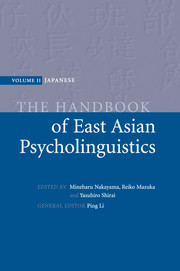Book contents
- Frontmatter
- Contents
- List of figures
- List of contributors
- In memory of Miwa Nishimura
- Preface
- Introduction
- Language acquisition
- Part II Language processing
- 26 The phonetic and phonological organization of speech in Japanese
- 27 Speech segmentation by Japanese listeners: its language-specificity and language-universality
- 28 Prosody in sentence processing
- 29 Speech errors
- 30 Effects of word properties on Japanese sentence processing
- 31 Orthographic processing
- 32 Lexical access
- 33 Incrementality in Japanese sentence processing
- 34 Processing alternative word orders in Japanese
- 35 Processing relative clauses in Japanese: coping with multiple ambiguities
- 36 Processing empty categories in Japanese
- 37 The difficulty of certain sentence constructions in comprehension
- 38 Reading and working memory
- 39 Sentence production in Japanese
- 40 The neural basis of syntactic processing in Japanese
- 41 The competition model
- 42 Connectionist models
- 43 Computational linguistics
- 44 Language and gesture as a single communicative system
- References
- Name index
- Subject index
42 - Connectionist models
from Part II - Language processing
Published online by Cambridge University Press: 05 June 2012
- Frontmatter
- Contents
- List of figures
- List of contributors
- In memory of Miwa Nishimura
- Preface
- Introduction
- Language acquisition
- Part II Language processing
- 26 The phonetic and phonological organization of speech in Japanese
- 27 Speech segmentation by Japanese listeners: its language-specificity and language-universality
- 28 Prosody in sentence processing
- 29 Speech errors
- 30 Effects of word properties on Japanese sentence processing
- 31 Orthographic processing
- 32 Lexical access
- 33 Incrementality in Japanese sentence processing
- 34 Processing alternative word orders in Japanese
- 35 Processing relative clauses in Japanese: coping with multiple ambiguities
- 36 Processing empty categories in Japanese
- 37 The difficulty of certain sentence constructions in comprehension
- 38 Reading and working memory
- 39 Sentence production in Japanese
- 40 The neural basis of syntactic processing in Japanese
- 41 The competition model
- 42 Connectionist models
- 43 Computational linguistics
- 44 Language and gesture as a single communicative system
- References
- Name index
- Subject index
Summary
Connectionism is a modeling approach for understanding cognitive processes (for example, see Haykin, 1994). A connectionist model consists of nodes (mathematically modeled neuron-like elements) that are interconnected to each other through connection weights. A connectionist model learns to perform a cognitive task through processing of given input stimuli, and, in many models, feedback to the model's response. It can learn to process rule-like behaviors along with exceptions to rules. Thus, connectionist models are often used to demonstrate the importance of learning over innate knowledge, and to argue for nonmodular cognitive architecture (e.g. Seidenberg & McClelland, 1989).
Connectionism has been applied at all levels of Japanese sentence processing, from phonology (Ijuin et al., 1999), lexical-semantics (Tsuzuki, 1996, Ma et al., 2000), to syntax and sentential semantics (Negishi & Hanson, 2001; Tsuzuki et al., 1999; Motoki, Watanabe & Shimazu, 1998). A reasonable question to ask is what kind of unique contribution the connectionist research in Japanese psycholinguistics can make. Unlike English, both phonetic characters (katakana and hiragana) and ideographical characters (kanji) are used in Japanese. There are many Japanese words that have different kanji spellings but the same sound (and thus the same hiragana/katakana spelling). Syntactically, it is a head-final language and has case particles. In this chapter, connectionist models of Japanese sentence processing are examined, focusing on connectionist architecture, the claims made by connectionist models, and the use of linguistic features particular to Japanese.
- Type
- Chapter
- Information
- The Handbook of East Asian Psycholinguistics , pp. 315 - 322Publisher: Cambridge University PressPrint publication year: 2006



